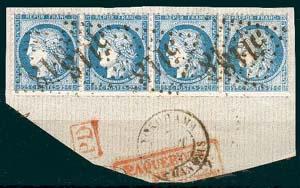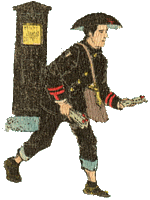Foreign Postal Systems in |
|
Correspondence to and From the US (Perry) Expedition to Japan .
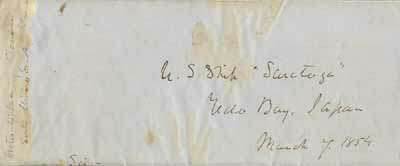 (Intra-Squadron Correspondence, 1854.3.7, Yedo Bay, Japan) The presence of the Perry Squadron in Japanese waters can be viewed as the first American postal system to operate in Japan. Despite the unwelcome presence of the American Squadron in Japanese waters, United States mail/correspondence was moving to and from Japan and Okinawa as a result of the Expedition. Ryohei Ishikawa, an eminent Japanese philatelist, formed a collection which is know as The Forerunner Foreign Post Offices in Japan: British-US-French, Ryohei Ishikawa's Collection. In 1976 a catalogue of this collection was published. It is interesting to note that the first "forerunner" cover shown from the collection is a Japan Expedition cover. It is an "On Public Service" cover (unfranked) showing a return address of "U.S. Steam Frigate Susquehanna." The enclosed letter from Commodore Perry was dated May 28, 1853 and he directed the US Steamship Caprice to proceed to Naha, Loo Choo Island. The letter indicated the Susquehanna was off the China coast when it was written. It appears that expedition mail/correspondence could flow through several possible avenues.
The main operating base of the squadron was Hong Kong. For this reason, inbound correspondence was very often addressed in "care of" the United States / American Consul in Hong Kong.
It is my experience that correspondence to and from members of the expedition is very scarce. Below is an outstanding example of correspondence delivered to an Expedition member in Jeddo (Jedo/Yedo) Bay, Japan, in March, 1854.  Picture Courtesy of Richard Frajola Recd Jeddo Bay, Japan John Sewall was the "Captain's Clerk" on the Saratoga. He kept a log of the Expedition and that was published in as The Logbook of the Captain's Clerk: Adventures in the China Seas in 1905 and reprinted in 1995.
March 19, 1854 was the day the Supply joined the Perry's Squadron in Jeddo Bay bringing it to a strength of 9 ships. For more information on the composition of Perry's Squadron for the second landing in Japan, click here.
Richard Frajola
 The correspondence is all stampless and the envelopes contain no postmarks or postal markings. All the letters, except one, originated in the Far East (8 from China, 1 "Yedo Bay"). One of the letters is from Townsend Harris to Dr. Morrow. Townsend Harris would soon be appointed the first US Consul General for Japan. For detailed information on this material, click here. |
|
Other Early Correspondence to and from Japan.
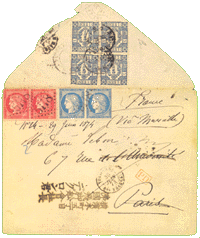 (An 1874 Japan to France Cover from the Ryohei Ishikawa Collection) |
The earliest somewhat detailed discussion I have found of the Japanese Postal system is the account by Philipp Von Siebod in the 1841-2 book, Manners and Customs of the Japanese, in the Nineteenth Century: From the Accounts of Recent Dutch Residents of Japan, and from the German Work of Dr. Ph. Fr. Von Siebold. Von Siebold resided at the Dutch trading of community Deshima from August of 1823 until October of 1829. Here is how he described the Japanese system for the posting of letters:
A post for letters is established throughout the empire, which, though pedestrian, is said to be wonderfully expeditious. Every carrier is accompanied by a partner, to guard against the possibility of delay from an accident that may chance to befall him. The men run at their utmost speed, and, upon approaching the end of their stage, find the relay carriers waiting for them, to whom the packet is tossed the moment they are within reach of each other: thus the relay postmen have already started before the arriving postmen have stopped. The greatest prince of the empire, if he meet the postmen on the road, must, give way, his whole train, and take care that their course is not obstructed by him or his. (Manners and Customs, at p. 230) This sounds like the American Pony Express system but on foot. It is interesting to note that the above passage is lifted verbatim (with no attribution) and placed in the official Narrative of the Expedition (See Volume 1, page 54). Obviously, the Manners and Custom's book was at hand and relied upon by Hawks as he wrote this entry in the Narrative.
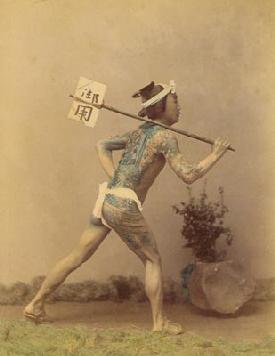 A Japanese Postman From Japan Described and Illustrated, 1897 The presence of foreigners in Japan created a need for established systems of post to handle mail in and out of Japan. International mail into and out of Japan prior to 1860 is very scarce. The mail from 1860~1880 is scare but not as scarce as the earlier mail. To satisfy the need for a reliable postal system for international mail, the French and British and Americans each established their own postal systems paralleling the Japanese system. British Postal Agency in Japan (BPA). The British maintained postal activities in Yokohama, Nagasaki and Hyogo/Kobe.
The outbound British mail generally carried Hong Kong stamps which were canceled with "Y1" (Yokohama), "N2" (Nagasaki) or "D30" (Kobe/Hyogo) cancels.
Outbound Reregistered Letter, 1873 
Inbound mail was also processed through the BPA and the earliest cover I am aware of was dated (letter inside) in April of 1860 and addressed to Nagasaki.
The earliest French cover into Japan that I am aware of was sent in May of 1863 and went via the French Post Office in Shanghai. These letters bear French stamps and the obliterating cancel with the number 5118 or, for those that passed through Shanghai, the obliterating cancel of 5104. They also were generally marked with the circular date cancel of Yokohama - Bau Francais. Mail in-bound to the French Post Office in Yokohama during this period often bears a Hong Kong transit cancel.
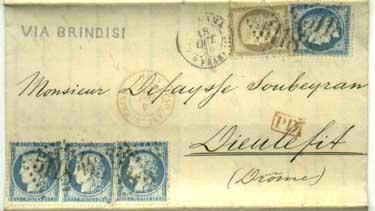 Large Number "5118" and "YOKOHAMA / Bau FRANCAIS"
Mixed Franking - French and Japanese Stamps 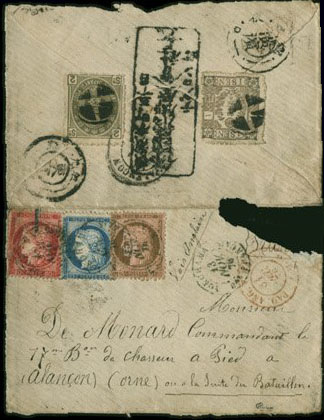
The very early USPO-Japan covers (prior to 1867) are perhaps the most obscure/scarce international covers out of Japan. The earliest cover I am aware of was a 1860 cover to Portland with a US 10c adhesive and marked "From Hokodate by the Orbit." During the Civil War service from Japan was suspended. In January of 1867 the service resumed. This mail bears US adhesive stamps. This mail is often hard to date with precision. The US cancels (both dispatch cancel from Japan and arrival cancel in the US) did not have a year date. However, ship sailing records (departure and arrival dates) have been compiled and based upon these records the date of a cover can generally be pin pointed. Records of "Pacific Crossings" have been compiled by the Japanese Philatelic Society in a monogram titled Pacific Crossings from Japan, 1858-79, I.S.J.P. Monograph 3, December, 1969. For more information on this publication, click here. These US postal service activities were ended by a postal convention between the US and Japan in August of 1873 (see below). All four US Postal activities in Japan were officially closed by the end of 1874 (over a year after the signing of the convention) and Japan stated it's own foreign mail service on January 1, 1875.
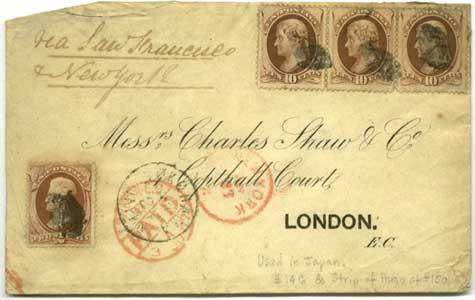 Yokohama, Japan transit cancel
 (An 1874 Japan to France Cover from the Ryohei Ishikawa Collection) The Japanese stamps carried the cover to Yokohama. The Japanese language handstamp you see on the face is know as a "Degron-kun" marking. It indicates the cover is for "Degron, French Postmaster of Yokohama." Henri Joseph Degron served as the head of the French Post Office in Yokohama during the entire time it was open (1865-1880). The French postal activity would then cancel the cover and dispatch it for delivery. The Dregon-kun covers were from French Military Mission personnel then stationed in Japan. On rare occasions, these covers are found with an address reading "to Mr. Degron, French Postmaster, Honcho 5 chome, Yokohama..." It is known that for some covers, the French stamps were added after the cover arrived in Yokohama.  Before April 20, 1871, domestic postal services in Japan were handled by private couriers. There was no governmental system in existence for mail destined within or outside Japan. The new Meiji Government established a small planning bureau in 1868 to implement a postal system for the country (Ekitei Katari - Postal Communications Section). Japan began issuing postage stamps on April 20, 1871 which is the same day Government postal service began. The new postal service had a Foreign Mail Department which was established with the assistance of assistance of employees of the US Consular Post Offices. The first stamp issue has fine hand engraved detail and features a dragon on either side of the denomination (48 mon, 100 mon, 200 mon and 500 mon). The are referred to by collectors of Japanese postage stamps as the "Dragon Series" for this reason. These stamps are on the expensive side and have been extensively forged over the years. Unless you have the expertise to authenticate them yourself, the best course to follow is to presume they are forged unless they have been authenticated (in writing with photograph) by a competent philatelic body (like the APS or ISJP). The same goes for just about any expensive Japanese stamp up to 1899. Postal stationery (postal cards, etc - with pre printed indicia of payment of postage) were first issued in June of 1871, a few months after the stamps. Initially mail service was only available between Tokyo and Osaka. By 1872 it was extended from Osaka to Nagasaki. By the end of 1874 there were over 3000 post offices open in Japan. Japan's foreign mail postal sections opened in Yokohama, Hiogo (Kobe) and Nagasaki on January 1, 1875. However, as of 2006 the earliest cancel reported is January 8 (Yokohama). These covers are complicated to date as the cancels do not have the year. From 1875 thorough April 19, 1934 Japanese foreign mail cancels carried the designation "Japan." From April 20, 1934 through 1949 the designation was changed to "Nippon" and then it reverted back to "Japan."
Philatelic References:Ishikawa, Ryohei: The Forerunner Foreign Post Offices in Japan, British - U.S.- French, Tokyo, Japan Philatelic Publications, Inc, printed by Kyodo Insatsu, 1976, large 8vo (7 1/4 x 9 in), red covers with gilt titles on front cover and spine, no dust jacket, numerous illustrations (most in color), 164 pp. The book is primarily in Japanese but the key illustrations have English descriptive titles. Accompanying the book is an 11 page English language pamphlet that discusses the early foreign post offices in Japan. The book presents philatelic material (covers and stamps) from Ishikawa's award winning philatelic collection of foreign mail and post offices (British, United States and France) operating in Japan from the 1860s through the 1880s. Numerous covers (franked envelopes) and canceled stamps are presented in color with descriptive titles. A key reference for this very rare material. The first cover pictured in the book is an official (Public Business) cover from Commodore Perry aboard the Susquehanna with a letter dated May 23, 1853. This letter would have been written while Perry was en route to Okinawa (arriving May 26) from China. The American Philatelist, Journal of the American Philatelic Society of March 2004 (Volume 118, No. 3, Whole No. 1,238) has an article entitled "Newly Discovered U.S. Naval Marking from Hong Kong" (pages 228-229) by John Birkinbine II that deals with mail from the East India Squadron in the 1850s-1860s. The article deals with a U.S. Navy Depot that was established in Hong Kong to serve the East India Squadron. The author notes that from March 1856 until 1863 William Speiden was the Naval Storekeeper at the Hong Kong Depot. Speiden served as a purser's clerk aboard the Mississippi during the Japan expedition. The article features a cover with an oval handstamp containing an eagle and 32 stars with the legend "United States Naval Depot Hong Kong." It appears this is the only recorded example of this marking.
Riddell, John D. and Sheila:
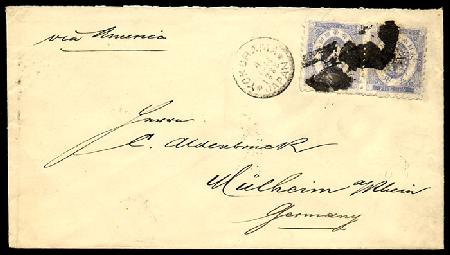 Perry was keenly aware that the opening of Japan and the establishment of mail routes through Japan via a Pacific route would greatly speed up the flow of mail from the Far East. In a paper read before the American Geographical and Statistical Society, March 6, 1856, he observed:
Mail System of 19th Century Japan 1877, William Elliot Griffis. In his book of 1877 (The Mikado's Empire), William Elliot Griffis has a note on the Japanese postal system of 1874-5. Griffis' comments on the very rapid growth of the Japanese Postal System and the efforts by the Government of Japan to reassert control over foreign mail in and out to the country. He notes the signing of a postal convention by the US and Japan in August of 1873 returning authority over foreign mail to Japan. For more information on the Griffis' comments on the Japanese postal system of 1874-5, click here. 1882, Thomas Van Buren. The US Consul General to Japan, Thomas Van Buren offered these comments regarding the state of the mail system in Japan in the early 1880s.
Mails.-- The mail transportation that has been established within the last ten years, both coastwise and inland, is cheap and excellent. The number of miles of mail routes aggregates 36,052. The number of Post Offices is 3,927. The number of letters carried for the year ending June 30th, 1880, was 55,775,206, and that of newspapers 11,203,731. These figures throw great light upon the volume of business of the country and the amount of reading writing done by the people. [Thomas Van Buren, Labor in Japan - published together with - Pottery and Porcelain Industries of Japan, Yokohama, Japan Printed at the Japan Gazette Office, 1882 (Quote from the Report on Labor in Japan, page 19)]. For more information on that book, click here.
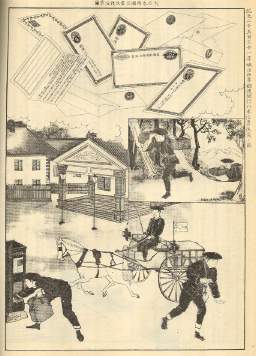 From Fuzohu Gaho, August 1891
 |
